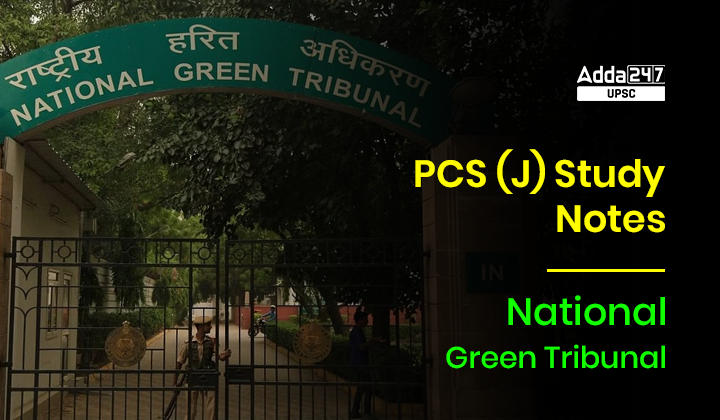Table of Contents
National Green Tribunal
What is National Green Tribunal?
For the purpose of efficiently and effectively resolving disputes involving the preservation of the environment, forests, and other natural resources, the National Green Tribunal was established in 2010 by the National Green Tribunal Act. After Australia and New Zealand, India is the third country overall and the first developing country to establish a dedicated environmental tribunal. Among the five locations where hearings before the National Green Tribunal can take place—Bhopal, Pune, New Delhi, Kolkata, and Chennai—New Delhi serves as the National Green Tribunal’s principal seat.
In 1986, the Supreme Court felt the need for a National Green Tribunal to resolve matters related to environmental protection in the Oleum gas leak case, and again in 2003 in the law commission’s 186th report. The National Green Tribunal was established by law as a judicial body to resolve legal cases as quickly as possible when they involve issues of conservation and preservation of natural resources. When making decisions, the National Green Tribunal relies solely on natural justice rather than the Code of Civil Procedure (1908) or the Indian Evidence Act (1872).
The Central Government appoints the National Green Tribunal’s Chairperson in conjunction with India’s Chief Justice. The National Green Tribunal should have at least 10 and no more than 20 full-time Expert Members and Judicial members. They were all chosen by the Selection Committee set up by the Union Government. These officials can serve for a maximum of 5 consecutive years without being eligible for re-election or reappointment.
Functions of National Green Tribunal
- All appeals and applications filed with the National Green Tribunal must be resolved within 6 months of the date they were filed.
- As a result of the National Green Tribunal’s involvement, the High Courts’ environmental caseload has been reduced.
- In cases of injury or property damage, the National Green Tribunal provides temporary relief and compensation.
- In environmental disputes, experts from a wide range of fields can come together at the National Green Tribunal.
National Green Tribunal Act
Article 21 of India’s Constitution establishes the National Green Tribunal Act, 2010 to protect citizens’ rights to a pollution free and healthy enviornment. The National Green Tribunal was established by the National Green Tribunal Act to provide victims of environmental, personal injury, or corporate liability with faster access to justice and more adequate compensation.
- The National Green Tribunal’s composition is laid out in Section 4 of the National Green Tribunal Act. The National Green Tribunal is comprised of a chairperson, judicial members, and expert members.
- The National Green Tribunal shall have jurisdiction over civil cases which are consistent with environmental matters pursuant to section 14 of the National Green Tribunal Act. The deadline for filing an application is six months after the case was initially filed.
- The National Green Tribunal shall have the authority necessary to regulate its own procedure pursuant to section 19 of the act.
- The National Green Tribunal may issue any order or award relating to the substantial development pursuant to section 20.
- As stated in the act’s section 21, the decisions of the National Green Tribunal are final and binding on the parties involved.
- Failure to comply with a National Green Tribunal decision is met with deterrent punishment in accordance with section 26 of the act.

नेशनल ग्रीन ट्रिब्यूनल
नेशनल ग्रीन ट्रिब्यूनल क्या है?
पर्यावरण, वनों और अन्य प्राकृतिक संसाधनों के संरक्षण से जुड़े विवादों को कुशलतापूर्वक और प्रभावी ढंग से हल करने के उद्देश्य से, नेशनल ग्रीन ट्रिब्यूनल की स्थापना 2010 में नेशनल ग्रीन ट्रिब्यूनल एक्ट द्वारा की गई थी। ऑस्ट्रेलिया और न्यूजीलैंड के बाद, भारत समग्र रूप से तीसरा देश है और एक समर्पित पर्यावरण न्यायाधिकरण स्थापित करने वाला पहला विकासशील देश है। उन पांच स्थानों में जहां नेशनल ग्रीन ट्रिब्यूनल के समक्ष सुनवाई हो सकती है-भोपाल, पुणे, नई दिल्ली, कोलकाता और चेन्नई-नई दिल्ली नेशनल ग्रीन ट्रिब्यूनल की प्रमुख सीट के रूप में कार्य करती है।
1986 में, सर्वोच्च न्यायालय ने ओलियम गैस रिसाव मामले में पर्यावरण संरक्षण से संबंधित मामलों को हल करने के लिए एक राष्ट्रीय हरित न्यायाधिकरण की आवश्यकता महसूस की, और फिर 2003 में विधि आयोग की 186वीं रिपोर्ट में। नेशनल ग्रीन ट्रिब्यूनल को कानूनी मामलों को जल्द से जल्द हल करने के लिए एक न्यायिक निकाय के रूप में कानून द्वारा स्थापित किया गया था जब वे प्राकृतिक संसाधनों के संरक्षण और संरक्षण के मुद्दों को शामिल करते हैं। निर्णय लेते समय, राष्ट्रीय हरित न्यायाधिकरण नागरिक प्रक्रिया संहिता (1908) या भारतीय साक्ष्य अधिनियम (1872) के बजाय केवल प्राकृतिक न्याय पर निर्भर करता है।
केंद्र सरकार भारत के मुख्य न्यायाधीश के साथ मिलकर नेशनल ग्रीन ट्रिब्यूनल के अध्यक्ष की नियुक्ति करती है। नेशनल ग्रीन ट्रिब्यूनल में कम से कम 10 और पूर्णकालिक विशेषज्ञ सदस्य और न्यायिक सदस्य 20 से अधिक नहीं होने चाहिए। उन सभी का चयन केंद्र सरकार द्वारा गठित चयन समिति द्वारा किया गया था। ये अधिकारी पुन: चुनाव या पुनर्नियुक्ति के लिए पात्र हुए बिना लगातार अधिकतम 5 वर्षों तक सेवा दे सकते हैं।
नेशनल ग्रीन ट्रिब्यूनल के कार्य
- नेशनल ग्रीन ट्रिब्यूनल में दायर सभी अपीलों और आवेदनों को दायर किए जाने की तारीख से 6 महीने के भीतर हल किया जाना चाहिए।
- नेशनल ग्रीन ट्रिब्यूनल की भागीदारी के परिणामस्वरूप, उच्च न्यायालयों का पर्यावरणीय केसलोड कम हो गया है।
- चोट या संपत्ति के नुकसान के मामलों में, राष्ट्रीय हरित अधिकरण अस्थायी राहत और मुआवजा प्रदान करता है।
- पर्यावरण संबंधी विवादों में, राष्ट्रीय हरित न्यायाधिकरण में कई क्षेत्रों के विशेषज्ञ एक साथ आ सकते हैं।
राष्ट्रीय हरित न्यायाधिकरण अधिनियम
भारत के संविधान का अनुच्छेद 21 प्रदूषण मुक्त और स्वस्थ पर्यावरण के लिए नागरिकों के अधिकारों की रक्षा के लिए राष्ट्रीय हरित न्यायाधिकरण अधिनियम, 2010 की स्थापना करता है। नेशनल ग्रीन ट्रिब्यूनल की स्थापना नेशनल ग्रीन ट्रिब्यूनल एक्ट द्वारा पर्यावरणीय, व्यक्तिगत चोट, या कॉर्पोरेट दायित्व के पीड़ितों को न्याय तक त्वरित पहुँच और अधिक पर्याप्त मुआवजे के साथ प्रदान करने के लिए की गई थी।
- राष्ट्रीय हरित न्यायाधिकरण की संरचना राष्ट्रीय हरित न्यायाधिकरण अधिनियम की धारा 4 में निर्धारित की गई है। नेशनल ग्रीन ट्रिब्यूनल में एक अध्यक्ष, न्यायिक सदस्य और विशेषज्ञ सदस्य शामिल हैं।
- नेशनल ग्रीन ट्रिब्यूनल के पास सिविल मामलों पर अधिकार क्षेत्र होगा जो राष्ट्रीय ग्रीन ट्रिब्यूनल अधिनियम की धारा 14 के अनुसार पर्यावरणीय मामलों के अनुरूप हैं। आवेदन दाखिल करने की समय सीमा शुरू में मामला दर्ज होने के छह महीने बाद है।
- राष्ट्रीय हरित अधिकरण के पास अधिनियम की धारा 19 के अनुसार अपनी स्वयं की प्रक्रिया को विनियमित करने के लिए आवश्यक अधिकार होंगे।
- राष्ट्रीय हरित अधिकरण धारा 20 के अनुसरण में पर्याप्त विकास से संबंधित कोई भी आदेश या अधिनिर्णय जारी कर सकता है।
- जैसा कि अधिनियम की धारा 21 में कहा गया है, राष्ट्रीय हरित अधिकरण के निर्णय अंतिम और शामिल पक्षों पर बाध्यकारी होते हैं।
- अधिनियम की धारा 26 के अनुसार नेशनल ग्रीन ट्रिब्यूनल के निर्णय का पालन करने में विफल रहने पर कठोर दंड दिया जाता है।
FAQs
1. Where is the National Green Tribunal’s principal seat?
Ans: New Delhi
2. Which Article of Indian Constitution Establishes National Green Tribunal?
Ans: Article 21


 UPSC Prelims Exam Date 2024, Check New E...
UPSC Prelims Exam Date 2024, Check New E...
 UPSC Eligibility Criteria 2024- Age Limi...
UPSC Eligibility Criteria 2024- Age Limi...
 UKPSC RO ARO Result 2024 Out, Download M...
UKPSC RO ARO Result 2024 Out, Download M...







